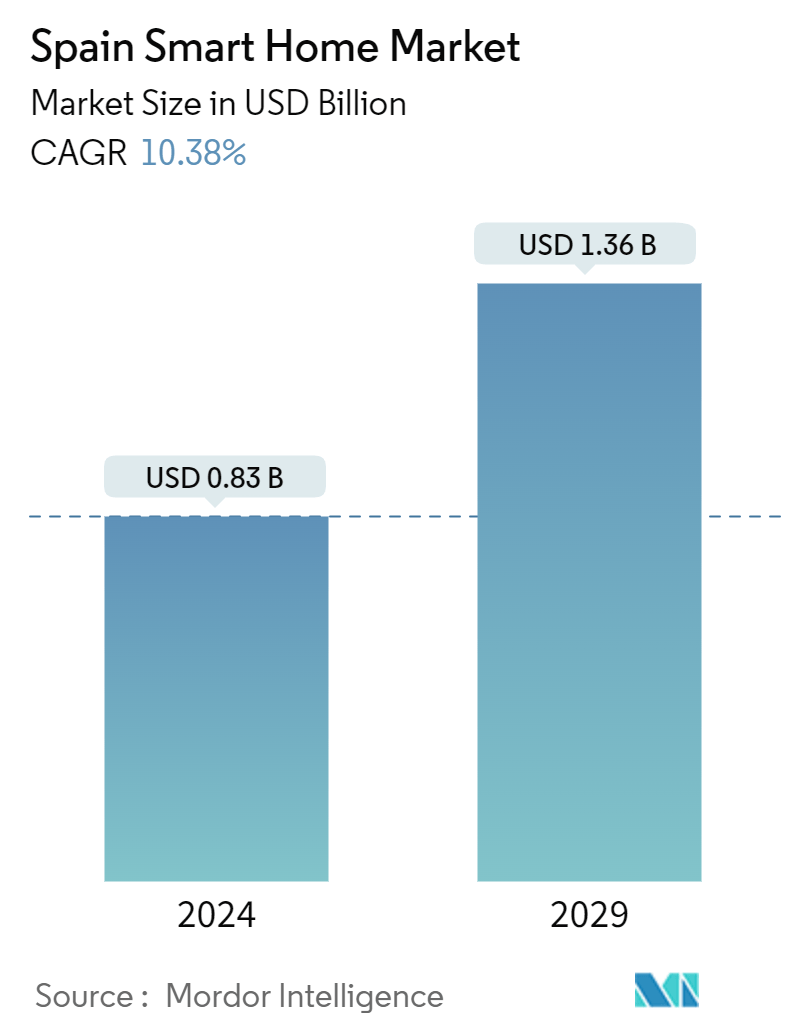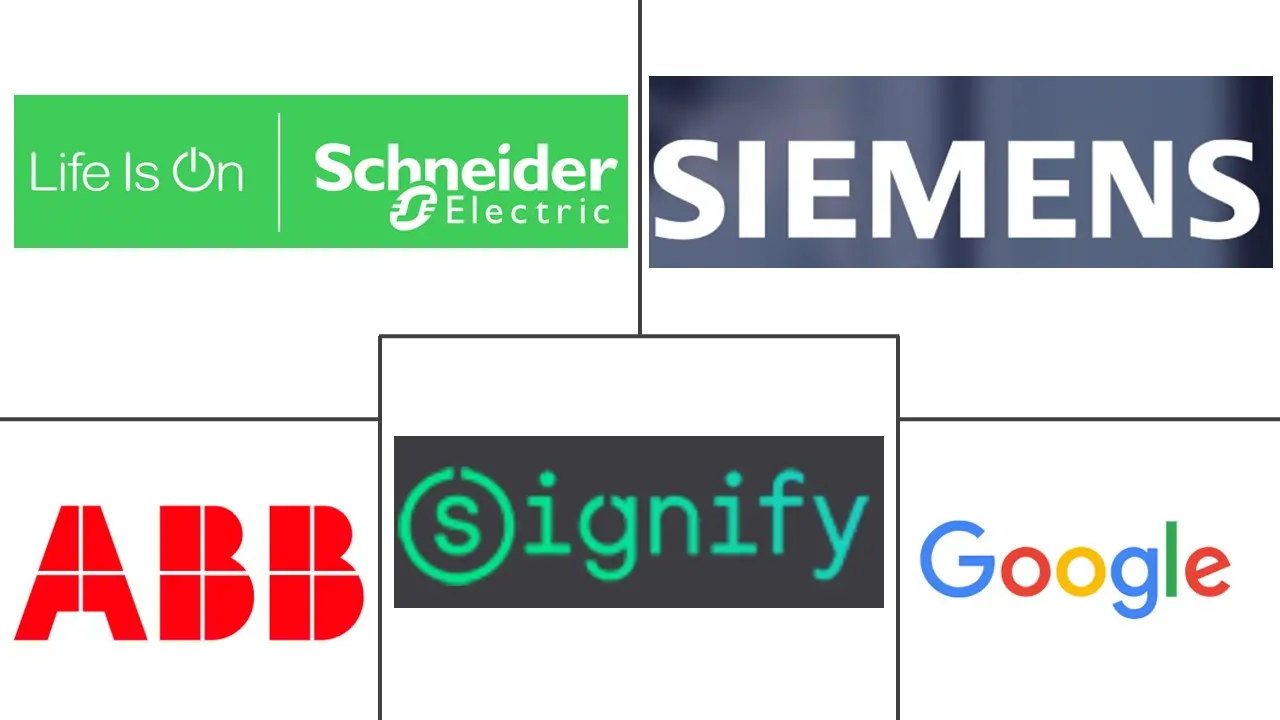Market Size of Spain Smart Home Industry

| Study Period | 2019 - 2029 |
| Base Year For Estimation | 2023 |
| Market Size (2024) | USD 0.83 Billion |
| Market Size (2029) | USD 1.36 Billion |
| CAGR (2024 - 2029) | 10.38 % |
| Market Concentration | Low |
Major Players
*Disclaimer: Major Players sorted in no particular order |
Spain Smart Home Market Analysis
The Spain Smart Home Market size is estimated at USD 0.83 billion in 2024, and is expected to reach USD 1.36 billion by 2029, growing at a CAGR of 10.38% during the forecast period (2024-2029).
- Spanish consumers are increasingly adopting smart home technology to enhance convenience, security, and energy efficiency. With the increasing use of connected devices and the Internet of Things (IoT), the market is experiencing a growing demand for smart home solutions that offer seamless integration and mobile app control. Homeowners seeking to streamline their daily routines and gain greater control over their home environments are turning to smart thermostats, lighting systems, security cameras, and other connected devices.
- Additionally, the rising interest in voice-controlled smart speakers and virtual assistants is another factor in the country's broad adoption of smart home devices. Leading devices such as Amazon Echo and Google Home are gaining traction among consumers, offering control over smart home gadgets and functions like music playback, information retrieval, and task execution, all through simple voice prompts. This surge underscores a clear move towards more brilliant, user-friendly home setups, emphasizing ease and accessibility.
- Spain's growing economy and increasing urbanization and digitalization create a conducive environment for expanding the smart home market. As more households in urban areas seek modern and technologically advanced living spaces, the demand for smart home solutions is expected to rise. Furthermore, government initiatives promoting innovation and technology adoption support the growth of the smart home industry in Spain, encouraging consumers and businesses to invest in connected devices and automation technologies.
- For instance, the Spanish government adopted a 'Digital Spain Agenda 2026' strategy, aiming to drive digital transformation and improve competitiveness, economic growth, and the welfare of Spanish society in the coming years. The initiative focuses on three core dimensions: enhancing infrastructure and technology, bolstering connectivity, and advancing cutting-edge technologies such as 5G, AI, and cybersecurity.
- In 2023, Spain's GDP rebounded, surging by 5.1% post the pandemic recession. This economic upturn bolstered consumer purchasing power, spurring a heightened interest in smart home technologies. With the average household disposable income in Spain hitting EUR 30,400 in 2023, marking a 3.7% increase from the previous year, more Spanish households found themselves in a position to embrace smart home innovations. Notably, as of 2023, 80% of Spain's population resided in urban areas. This urbanization shift is fueling a growing appetite, especially in major cities, for space-efficient and energy-saving smart home solutions.
- However, data privacy and cybersecurity concerns loom large, formidable hurdles to the widespread adoption of smart homes in the country. As smart home devices gain traction, so does the anxiety among consumers, paralleled by a surge in reported security incidents. With the proliferation of connected devices, the landscape is rife with fresh vulnerabilities, underscoring the critical need for robust security protocols and device fortifications.
Spain Smart Home Industry Segmentation
A smart home integrates devices communicating their status through information and communication technologies (ICT) and the Internet of Things (IoT) protocols. Smart home devices oversee and regulate various home features, encompassing lighting, climate, entertainment systems, and appliances. Additionally, they can incorporate home security elements like access control and alarm systems. The study tracks the revenue of different market players who sell various smart home products in Spain. It also tracks the key market parameters and underlying growth influencers that support the market estimations and growth rates during the forecast period. The study further analyzes the overall impact of macroeconomic factors on the market.
The Spanish smart home market is segmented by product (comfort and lighting, control and connectivity, energy management, home entertainment, security, and smart appliances). The market sizes and forecasts are provided in terms of value (USD) for all the above segments.
| By Product | |
| Comfort and Lighting | |
| Control and Connectivity | |
| Energy Management | |
| Home Entertainment | |
| Security | |
| Smart Appliances |
Spain Smart Home Market Size Summary
The smart home market in Spain is experiencing significant growth, driven by increasing consumer adoption of connected devices and the Internet of Things (IoT). Spanish homeowners are increasingly seeking smart home solutions that enhance convenience, security, and energy efficiency. This trend is fueled by the rising popularity of voice-controlled smart speakers and virtual assistants, which offer seamless control over various home functions. The market is further supported by Spain's growing economy, urbanization, and digitalization, creating a favorable environment for the expansion of smart home technologies. Government initiatives like the 'Digital Spain Agenda 2026' are also promoting innovation and technology adoption, encouraging both consumers and businesses to invest in smart home solutions.
The demand for smart lighting and home automation is particularly notable, with consumers seeking energy-efficient and space-saving solutions. Smart lighting not only enhances home security but also contributes to energy efficiency and sustainability goals. The market is characterized by strategic partnerships and collaborations among key players, such as Lumos Controls and Axoled, to strengthen their market positions. Despite the promising growth, challenges such as data privacy and cybersecurity concerns remain, necessitating robust security measures. The competitive landscape includes major companies like ABB Ltd, Schneider Electric SE, and Samsung Electronics Co. Ltd, which are actively expanding their global presence through strategic initiatives.
Spain Smart Home Market Size - Table of Contents
-
1. MARKET INSIGHTS
-
1.1 Market Overview
-
1.2 Industry Attractiveness - Porter's Five Forces Analysis
-
1.2.1 Bargaining Power of Suppliers
-
1.2.2 Bargaining Power of Buyers
-
1.2.3 Threat of New Entrants
-
1.2.4 Intensity of Competitive Rivalry
-
1.2.5 Threat of Substitute Products
-
-
1.3 Impact of COVID-19 Aftereffects and Other Macroeconomic Factors on the Market
-
1.4 Technology Snapshot
-
1.4.1 Major Communication and Connectivity Technologies Used in Smart Homes (Bluetooth, Wi-Fi, ZigBee, Z-Wave, Among Others)
-
1.4.2 Key Industry Standards and Policies
-
-
-
2. MARKET SEGMENTATION
-
2.1 By Product
-
2.1.1 Comfort and Lighting
-
2.1.2 Control and Connectivity
-
2.1.3 Energy Management
-
2.1.4 Home Entertainment
-
2.1.5 Security
-
2.1.6 Smart Appliances
-
-
Spain Smart Home Market Size FAQs
How big is the Spain Smart Home Market?
The Spain Smart Home Market size is expected to reach USD 0.83 billion in 2024 and grow at a CAGR of 10.38% to reach USD 1.36 billion by 2029.
What is the current Spain Smart Home Market size?
In 2024, the Spain Smart Home Market size is expected to reach USD 0.83 billion.

